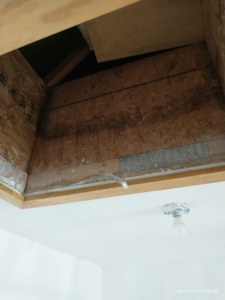Insulating and Sealing Attic Access Hatches
Why is it important to insulate and seal the attic access hatch in your home?
Insulating and sealing your attic access hatch is essential for several reasons.
One of them is energy efficiency. Especially during Minnesota winters. As we heat the air in our home, it will naturally rise towards the ceilings and upper levels. If an attic access hatch located on the ceiling is not well insulated and sealed, it will become a prime spot for the heated indoor air to make its way out of the place you want to keep it – indoors. As the warm air leaves the indoors through the attic hatch, it must be replaced with new air being brought into the home. Typically, this “makeup air” will be pulled from the outdoors through any cracks or gaps, often around windows, doors, and other openings in the home’s “envelope.”
Stack Effect
This natural rise and escape of warmer air and the drawing in of outdoor replacement air has a name in the home services industry. It is called “stack effect.” Every home will have some level of stack effect, but an excessive amount results in several issues:
- Higher Energy Bills: Your heating system must work harder to maintain a consistent temperature, leading to higher energy bills.
- Uneven Temperatures: Stack effect can cause temperature variations throughout your home, with the upper levels being warmer than the lower levels.
- Poor Indoor Air Quality: Stack effect can draw in outdoor air, along with any pollutants, allergens, or other contaminants, leading to poor indoor air quality.
- Increased Radon: Stack effect can increase the amount of radon in your home.
Moisture Problems in the Attic
Outside of energy-related concerns, a poorly insulated and sealed attic access hatch also has another significant consequence. It can be a major contributor to moisture and mold issues in your attic.
Warm air is capable of holding more moisture than cold air. When the warm air inside your home gets past the attic access hatch, it makes contact with the cold surfaces on the other side. The warm air then cools quickly and drops some of its moisture content. In the cold of winter, it is not unusual to find large amounts of frost in attics with poorly insulated and sealed hatches. The frost results from the dropped moisture freezing on the colder surfaces. On the next warm day, the frost melts and saturates nearby building materials, resulting in damage and potential mold growth. The picture below shows where warm, moist air has been moving through the attic hatch, causing mold growth on the cold plywood in the attic. For more info on frost in your attic, click here.

Best Way to Seal and Insulate your Attic Hatch
The attic access hatch door should have 12-18 inches of insulation applied to the backside (attic side). I recommend using foam-board insulation and gluing it directly to the hatch door. This method will make future removal of the door and gaining access as easy as possible without the mess of itchy fiberglass or loose-fill cellulose insulation. For sealing the door, a simple bead of acrylic, paintable caulk is all that is needed. Apply the bead around the interior side of the door edges.
[/av_textblock]





Leave a Reply
Want to join the discussion?Feel free to contribute!